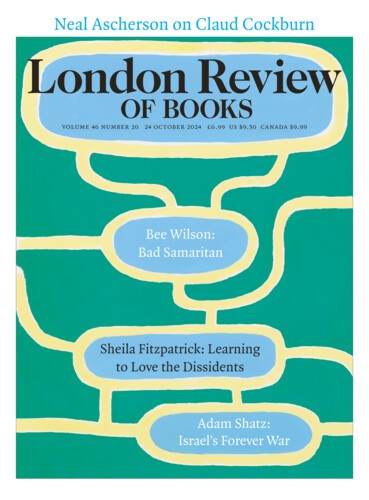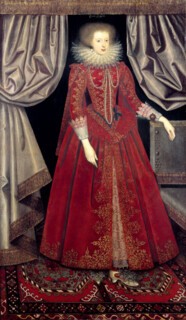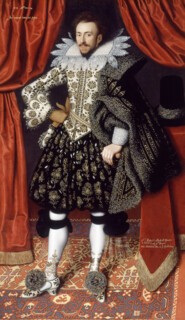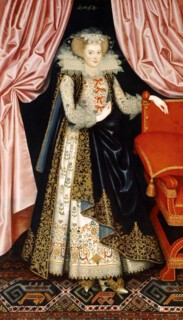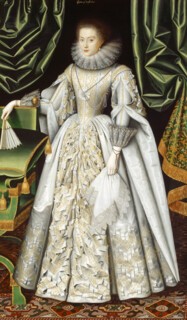In 1925, Edward Cecil Guinness, 1st earl of Iveagh, purchased Kenwood House, a neoclassical villa on the edge of Hampstead Heath and one of the finest surviving examples of the mature designs of Robert Adam. Two years later, Lord Iveagh died, bequeathing Kenwood to the nation, along with 63 Old Master and 18th-century British paintings from his own collection, including works by Rembrandt, Vermeer, Gainsborough and Reynolds, as an example of the house, and artistic holdings, of an 18th-century gentleman. Since 2001, Kenwood has also housed the Suffolk Collection: 59 paintings – mostly royal and family portraits, many of them by unknown artists – amassed over a 400-year period by the Howard family.
The jewel in the Suffolk Collection is a group of nine enormous, full-length portraits of members of the extended Howard family painted in the 1610s by the Jacobean portraitist William Larkin (c.1580-1619). These imposing, larger-than-life images are a riot of texture, pattern and colour, with little or no regard for linear perspective. Before the middle decades of the 20th century, when, thanks to the pioneering scholarship of James Lees-Milne and Roy Strong, Larkin’s identity was established and his oeuvre began to be reconstructed, paintings such as those in the Suffolk Collection were often referred to as ‘carpet and curtain pictures’ and attributed, for want of a better name, to the ‘Curtain Master’. Each sitter in the Kenwood group is shown dressed to the nines, standing on an ornate Turkish carpet next to a richly upholstered chair and/or a table covered with a gold-fringed cloth, the entire mise en scène framed – like a stage set – by lustrous, looped silk curtains. The paintings induce a quasi-sensory experience: you can almost feel the stiffness of the starched lace ruffs or the smooth nap of the velvets in which the sitters, and the furniture flanking them, are draped. The carpets are pitched at gravity-defying angles, threatening to slide off the canvas and onto the floor.
It is not clear why, and at whose behest, these were painted, though it’s reasonable to assume, as with the vast majority of Jacobean court portraits, that they were intended to commemorate individual or dynastic milestones. The person most likely to have commissioned them is the Howard matriarch Katherine Knyvett, second wife of Thomas Howard, 1st earl of Suffolk. Larkin painted Katherine wearing a red farthingale dress with gold embroidery and a ruff so large her head looks as if it were served up on a plate like John the Baptist’s.
A portrait of Katherine’s nephew Richard Sackville may have been intended to mark the lavish festivities, in February 1613, for the marriage of James I’s daughter Princess Elizabeth to Frederick V, the Elector Palatine. Richard – a notorious spendthrift – was one of a handful of courtiers who, according to one witness, ‘dazzled the eyes of all who saw the splendour of their dress’. Larkin’s Richard is captured for posterity in a cloth-of-silver doublet embroidered with black and gold, complete with matching gauntlets and shoes, a black velvet cloak slung across his left shoulder. More than four hundred years later, he still dazzles.
A sororal pairing shows the twins Lady Anne and Lady Diana Cecil, the younger daughters of William Cecil, 2nd earl of Exeter, in identical dress: a high-necked, gold-embroidered, cream satin gown with scalloped-edged slashes (through which the gold-coloured satin on the reverse can be glimpsed). It has been suggested that the paintings record their appearance as bridesmaids at the marriage, in 1614, of their elder sister, Lady Elizabeth, to Katherine Knyvett’s second son, Thomas Howard, though there is no firm evidence for this.
One sitter, thought to be Elizabeth Cary, cousin by marriage to Katherine Knyvett, strikes an unusual pose, draping a green velvet gown across her stomach. Was this gesture intended to indicate that she was pregnant at the time the portrait was painted (and its commissioning a celebration of the imminent birth of an heir)? Or was it simply a device for drawing attention to the richness of her dress – and Larkin’s skill at rendering fabrics? As is so often the case with English paintings of this period, we can’t be certain. The identity of the sitter in another portrait remains unclear – she could be either Isabella Rich or Lady Isabel Rich, both of whom were related, by marriage, to the Howards – but her pale yellow standing collar helps to date the painting, or at least provides a probable terminus ante quem for its completion. Yellow collars enjoyed a vogue at the early Jacobean court, but rapidly fell out of fashion after Anne Turner, who had started the fashion and held a monopoly on the supply of saffron-based starch, was hanged at Tyburn in 1615 for her role in the murder of Sir Thomas Overbury – a scandal that implicated the Howards. In passing sentence, Sir Edward Coke, Lord Chief Justice of the King’s Bench, condemned Turner to be hanged in a yellow ruff.
Like many English painters of the 16th and early 17th centuries, Larkin remains a shadowy figure. He is believed to have been born in London around 1580, his father perhaps the baker of that surname recorded in the parish of St Sepulchre-without-Newgate. But nothing is known of his early years, education or training as a painter. The first documented reference dates from 17 July 1606, the day he became a freeman of the Painter-Stainers’ Company (which included ‘fine art’ painters, but also house painters, sign painters and the like). With the help of two high-ranking and well-connected patrons, Lady Arbella Stuart and Edward Seymour, 1st earl of Hertford, Larkin was made free of the company by redemption, that is, on payment of a fee. How and why Larkin should have found himself in a position to bypass the formal apprenticeship of seven years, known as servitude, is unknown. Freedom by redemption was sometimes granted to those who had already completed an apprenticeship in a parallel craft with another London livery company. But if that was true for Larkin, no evidence has emerged to prove it.
What isn’t in doubt is that Larkin enjoyed an impressive level of patronage from the outset of his career. The poet Edward Herbert sat for him in 1609 or 1610, as did his good friend Sir Thomas Lucy. These are compact, rather sober portraits in which the sitters are depicted against dark backgrounds, clad in comparatively restrained black habits embroidered with gold. Both are at Charlecote Park, near Stratford-upon-Avon, historically the Lucy family estate. An anecdote in Herbert’s autobiography suggests that these portraits may have been commissioned to commemorate a dramatic incident in 1609, when he dragged a seasick, half-dead Lucy to safety after their ship foundered on Dover pier, saving him from drowning.
Another passage in Herbert’s autobiography reveals that Larkin, apparently without Herbert’s knowledge or permission, produced additional versions of the Herbert portrait, perhaps for sale, perhaps for presentation to other would-be patrons at the Jacobean court. One of these was copied in watercolour on vellum by the miniature-painter Isaac Oliver – Hilliard’s most celebrated pupil – at the request of Lady Eyre (whose husband stabbed Herbert in 1611, believing him to be having an affair with his wife). Another was acquired by Richard Sackville, though whether that was before, or after, 1613, when Sackville sat for the portrait now at Kenwood, is unclear. A third occupied a prominent place in the picture collection of someone enigmatically described in Herbert’s autobiography as a person ‘of even greater rank’.
Larkin also painted Richard’s wife, Lady Anne Clifford, who sat for him at Knole – one of many properties owned by the Sackvilles in the early 17th century – in the summer of 1618, an event recorded in her diary. The template devised on that occasion, in which Lady Anne, richly attired, is depicted in half-length against a dark background, gave rise to at least two paintings: one now at Knole, the other in the National Portrait Gallery – perhaps the painting mentioned in one of her diary entries as having been sent as a gift to a cousin in Surrey.
Francis Manners, 6th earl of Rutland, also patronised Larkin. He commissioned at least two (now lost) paintings, one of which, executed in 1619 (shortly before Larkin’s death), depicted his daughter, Lady Katherine. Larkin received £30 for each. What that would be in today’s money is difficult to say, but it seems to have been an eye-wateringly large sum by the standards of the day. Rowland Lockey – another London-based painter active at the Jacobean court who worked in the style of Hilliard – received just £50 for painting close to forty life-sized portraits for William Cavendish between 1609 and 1613 (though most of these seem to have been copies of pictures of Cavendish’s Elizabethan forebears rather than new commissions).
The portraits for which Lord Rutland paid Larkin £30 were presumably similar in size, scale and conception to those in the Suffolk Collection. Or, to put it another way, £30 per painting is probably a reasonable guide to what Larkin was paid for the nine ‘carpet and curtain’ pictures now at Kenwood. What Larkin charged for smaller, more modest, portraits – such as those he did for Edward Herbert and Thomas Lucy and Lady Anne Clifford – isn’t recorded. This much, however, is clear: to commission a larger-than-life, full-length portrait from Larkin was to make a bold statement about rank and status. Not only do the paintings themselves unashamedly showcase their sitters’ wealth, to be portrayed by Larkin was – to borrow a term not coined until 1899 – an act of conspicuous consumption.
Regular visitors to Kenwood will have grown accustomed over the years to seeing the Larkins in the Suffolk Collection clustered together in the (often rather dimly lit) first-floor drawing room, alongside a battered Turkish carpet of a similar date to those portrayed in Larkin’s portraits. Strike a Pose: Stephen Farthing and the Swagger Portrait (until 3 November), mounted to mark the fiftieth anniversary of the gift of the Suffolk Collection to the nation, offers an opportunity to consider Larkin’s portraits afresh. This imaginative exhibition juxtaposes seven of the Suffolk Larkins with two new works by Farthing inspired by Larkin’s example. Moreover, it does so in a space that has been re-lit to magnificent effect. At long last, it is possible to see Larkin’s paintings clearly, even on an overcast day.
One of Farthing’s new paintings, A Dance to the Music of Time, takes Larkin’s portrait of Lady Diana Cecil as its point of departure; two nearly identical versions of the subject are placed side by side as if to suggest a mirror image. The other, Will You Still Love Me Tomorrow?, riffs on Larkin’s paintings of Richard Sackville and Elizabeth Cary, treating them as a double portrait. Completed during lockdown, with recourse only to online images, Farthing’s Larkin-inspired works have been painted in a fluorescent, day-glo palette, giving them something of the computer screen’s luminescent smoothness.
The wall texts are minimal and comprised mainly of quotations from Farthing describing his reactions to the Larkins. Some of these relate to the character of the sitters and the roles they wished Larkin to help them perform in the eyes of both contemporaries and posterity. Richard Sackville, as immortalised by Larkin, is, for Farthing, a ‘gift-wrapped figure’ who ‘exists in a place somewhere between “crazy” and “wonderful”, like an exotic bird displaying his plumage’, while Katherine Knyvett looks as though she ‘has purposefully walked through the curtains and onto a stage in order to present herself to an audience’. Some of Farthing’s observations relate to the details of the painter’s craft. In the case of Larkin’s portrait of Isabella Rich/Lady Isabel Rich, it is the geometry of the composition that interests him: ‘a strangely modern-looking painting organised unusually around diagonal lines’.
Two of the Larkins normally on display at Kenwood – portraits of Elizabeth Cecil, Lady Burghley, and of Elizabeth Howard, later countess of Newcastle – are not on show for the duration of this exhibition. Currently being cleaned, they will return to the re-lit first-floor drawing room after Strike a Pose closes.
Send Letters To:
The Editor
London Review of Books,
28 Little Russell Street
London, WC1A 2HN
letters@lrb.co.uk
Please include name, address, and a telephone number.
